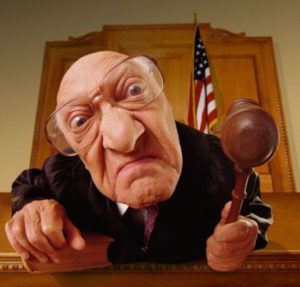A woman in Austin, Texas tripped over a toddler running inside a store, and broke her ankle. She sued the store owners, claiming they maintained an unsafe environment. The store had to pay $80,000 in damages. Everyone watching the case was shocked by the outcome, because the toddler was her own son!
A Philadelphia woman, arguing with her boyfriend in a restaurant, got so angry she threw a drink at him. She stormed away, slipping on the wet floor and breaking her tailbone. Never mind that the floor was wet because of the drink she herself had thrown; she was so angry she sued – not the boyfriend, but the restaurant, for having a wet floor. The owner ended up paying her $113,000.
Common sense notwithstanding, judges and juries in those cases couldn’t see who was at fault. In one recent forestry case, a federal judge pointed the finger at the U.S. Forest Service (USFS), when the blame actually belonged to the judge himself.
 Catastrophic fires burning thousands of acres of forests this summer have again highlighted the need for active forest management. While we often chide the USFS for its failure to thin dead and overgrown forests to a more natural level, in this case the agency actually tried. In Montana’s Lewis and Clark National Forest, the USFS attempted a very small-scale management effort, called the Stonewall Vegetation Project. It covered barely 5,000 acres, extremely modest when you consider the 100 million acres of forests lost to wildfires in recent years, and the millions more that are still overgrown, dying, and at risk.
Catastrophic fires burning thousands of acres of forests this summer have again highlighted the need for active forest management. While we often chide the USFS for its failure to thin dead and overgrown forests to a more natural level, in this case the agency actually tried. In Montana’s Lewis and Clark National Forest, the USFS attempted a very small-scale management effort, called the Stonewall Vegetation Project. It covered barely 5,000 acres, extremely modest when you consider the 100 million acres of forests lost to wildfires in recent years, and the millions more that are still overgrown, dying, and at risk.
This particular section of forest suffered massive beetle kill, and the Forest Service decided to salvage the dead trees on about 40 percent of it, burn the remainder to clear the overgrowth, and thus prevent a worse conflagration that could destroy much of the surrounding forest.
The Stonewall Project was proposed by a collaborative group of local stakeholders, supported by sportsmen’s groups, local governments, and conservationists. It was vetted through a six year review that produced over 2,600 pages of analysis. The decision documents were said to weigh over 13 pounds, so thorough was the process. Final maps were agreed upon in January, 2016, and the final approval was issued last August.
Despite that exhaustive process, done in compliance with all the procedural laws, two environmental industry groups (opposed to any cutting of any trees anywhere) filed suit to stop the logging portion. That got U.S. District Judge Dana Christensen involved, and the rest is very sad history. Just as the work was about to begin, the judge issued an injunction, saying the Forest Service had not proved that fire danger was “imminent.” Within two weeks of his ruling, lightning struck, and the resulting fire torched 9,000 acres of the forest and cost over $9 million to put out. As part of the injunction, he had scheduled the case for further review later (too late, obviously), and last month the case came back up for the formal hearing.
The Forest Service again tried to convince the same judge that such management projects are essential to healthy forests, again in vain. Ironically, the judge now blames everyone but himself, again insisting that the professionals have not done their jobs. In fact, he used the fire itself as an excuse to stop the remainder of the project. He has now remanded the Stonewall Vegetation Project for further analysis. Is there anything left to analyze?
This time, Judge Christensen wrote, “While there has been a fire demonstrating the risks of heavy fuel loads in the project area, (the Forest Service has) not explained why any delay… will increase the magnitude of this risk and, importantly, the fire has already occurred.” In fact, the fire absolutely proved that the delay – caused by the judge – increased the fire risk. Yet the same judge continues to say the Forest Service has not done its job. This Obama-appointed judge has no training in forestry at all, so his questioning of agency expertise was not only disingenuous, it was devastating to the forest, watershed, and wildlife habitat. Forest Service officials were trying to do their jobs; it was the judge himself who stopped them.
People should take responsibility for their own actions. That applies to the customer blaming the store for her own negligence, and to judges whose political agendas have such consequences. Like Billy Joel, this judge didn’t start the fire. But he sure as the world could have prevented it.
A version of this column originally appeared in the Grand Junction Daily Sentinel July 13, 2018.




Comments on this entry are closed.